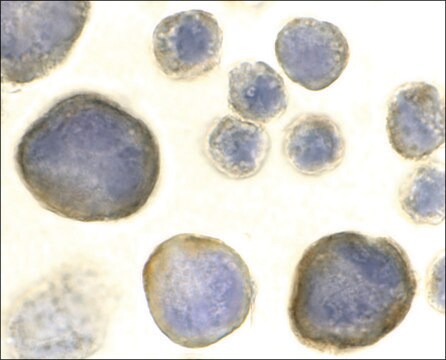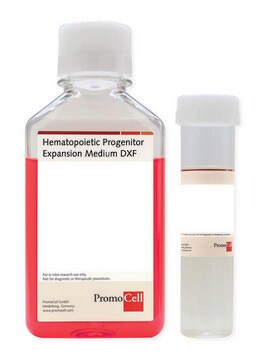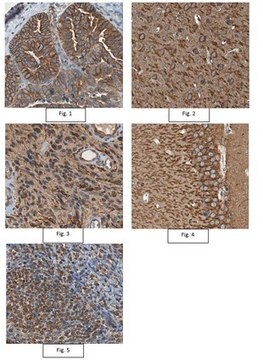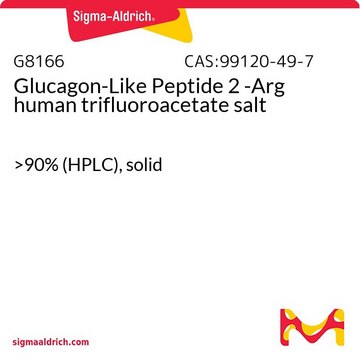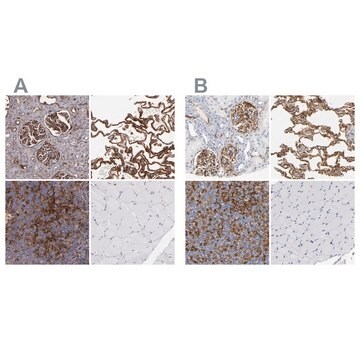C8352
Anti-CXCR4 (Fusin) (182-196) antibody produced in rabbit
IgG fraction of antiserum, buffered aqueous solution
Sign Into View Organizational & Contract Pricing
All Photos(1)
About This Item
Recommended Products
biological source
rabbit
Quality Level
conjugate
unconjugated
antibody form
IgG fraction of antiserum
antibody product type
primary antibodies
clone
polyclonal
form
buffered aqueous solution
species reactivity
human
technique(s)
western blot: 0.5-1 μg/mL using human HeLa cell extract
UniProt accession no.
shipped in
dry ice
storage temp.
−20°C
target post-translational modification
unmodified
Gene Information
human ... CXCR4(7852)
General description
Chemokine receptor CXCR-4 also refers as fusin or LESTR is a protein that belongs to G-protein coupled receptor 1 family. It is an essential cofactor for T cell-tropic HIV viruses into CD4+ cells. N-Terminal domain and second extracellular loop of the protein act as a HIV binding sites. Anti-CXCR4 (Fusin) (182-196) antibody can be used to block HIV-1 and HIV-2 fusion and infection of human target cells. Rabbit anti-CXCR4 (Fusin) (182-196) antibody reacts specifically with human CXCR4.
Immunogen
synthetic peptide corresponding to amino acids 182-196 of the second extracellular loop of human CXCR4.
Application
Anti-CXCR4 (Fusin) (182-196) antibody may be used in immunoblotting at a working antibody concentration of 0.5 - 1 μg/ml using human HeLa cell extract. It can also be used in immunohistochemistry.
Other Notes
The antigen (receptor) is also termed fusin, LESTER and HUMSTR.
Physical form
Solution in phosphate buffered saline containing 0.02% sodium azide.
Disclaimer
Unless otherwise stated in our catalog or other company documentation accompanying the product(s), our products are intended for research use only and are not to be used for any other purpose, which includes but is not limited to, unauthorized commercial uses, in vitro diagnostic uses, ex vivo or in vivo therapeutic uses or any type of consumption or application to humans or animals.
Not finding the right product?
Try our Product Selector Tool.
Storage Class Code
10 - Combustible liquids
WGK
WGK 1
Flash Point(F)
Not applicable
Flash Point(C)
Not applicable
Choose from one of the most recent versions:
Already Own This Product?
Find documentation for the products that you have recently purchased in the Document Library.
Raji R Nair et al.
NPJ aging and mechanisms of disease, 4, 9-9 (2018-09-06)
One of the major pathological outcomes of DNA damage during aging or anticancer therapy is enhanced inflammation. However, the underlying signaling mechanism that drives this is not well understood. Here, we show that in response to DNA damage, ubiquitously expressed
Karin Jennbacken et al.
The Prostate, 72(8), 913-924 (2012-01-31)
Tasquinimod (ABR-215050) is an orally active quinoline-3-carboxamide analog that has completed phase II clinical trial in patients with castration resistant prostate cancer, showing promising inhibiting effects on the occurrence of metastasis and delayed disease progression. Its mechanism of action is
Z Lu et al.
Proceedings of the National Academy of Sciences of the United States of America, 94(12), 6426-6431 (1997-06-10)
The chemokine receptor CXCR4 functions as a fusion coreceptor for T cell tropic and dual-tropic HIV-1 strains. To identify regions of CXCR4 that are important for coreceptor function, CXCR4-CXCR2 receptor chimeras were tested for the ability to support HIV-1 envelope
Verena Schwartz et al.
FEBS letters, 583(17), 2749-2757 (2009-08-12)
MIF is a chemokine-like inflammatory mediator that triggers leukocyte recruitment by binding to CXCR2 and CXCR4. MIF also interacts with CD74/invariant chain, a single-pass membrane-receptor. We identified complexes between CD74 and CXCR2 with a role in leukocyte recruitment. It is
J F Berson et al.
Journal of virology, 70(9), 6288-6295 (1996-09-01)
Entry of human immunodeficiency virus type 1 (HIV-1) into cells requires binding to CD4 and fusion with a cellular membrane. Fusion does not occur in most nonhuman cells even when they express human CD4, indicating that one or more human
Articles
Cancer stem cell media, spheroid plates and cancer stem cell markers to culture and characterize CSC populations.
Our team of scientists has experience in all areas of research including Life Science, Material Science, Chemical Synthesis, Chromatography, Analytical and many others.
Contact Technical Service